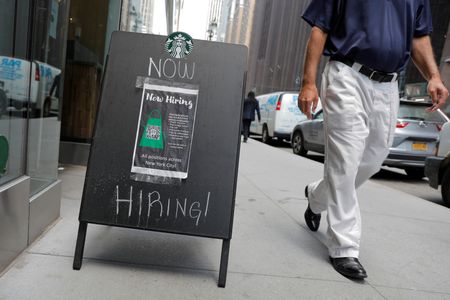By Lucia Mutikani
WASHINGTON (Reuters) – The number of Americans filing new claims for unemployment benefits increased modestly last week and private employers hired more workers than expected in May, pointing to continued labor market tightness that could push the Federal Reserve to keep interest rates elevated.
The labor market is slowing only marginally, keeping a much feared recession at bay for now, despite 500 basis points worth of interest rate hikes from the U.S. central bank since March 2022, when the Fed embarked on its fastest monetary policy tightening campaign since the 1980s to tame inflation.
“Labor market conditions are still tight,” said Nancy Vanden Houten, lead U.S. economist at Oxford Economics in New York. “While we expect the Fed to leave rates steady at its upcoming meeting, a more sustained loosening of labor market conditions is needed to keep rate hikes permanently off the table.”
Initial claims for state unemployment benefits rose 2,000 to a seasonally adjusted 232,000 for the week ended May 27, the Labor Department said on Thursday. Economists polled by Reuters had forecast 235,000 claims for the latest week.
They believe that claims have probably topped out for now, having barely budged from current levels for much of May.
Unadjusted claims increased by 5,296 to 207,941 last week, with notable rises in New York, Ohio and Illinois. Only 58 claims were filed in Massachusetts, which had been swamped by fraudulent applications in recent weeks.
There have been high-profile layoffs in the technology sector and industries sensitive to interest rates, such as housing, but employers have been generally hoarding workers after difficulties finding labor in the wake of the COVID-19 pandemic.
The government reported on Wednesday there were 10.1 million job openings at the end of April, with 1.8 vacancies for every unemployed person, well above the 1.0-1.2 range viewed as consistent with a labor market that is not generating too much inflation.
The number of people receiving benefits after an initial week of aid, a proxy for hiring, increased by 6,000 to 1.795 million during the week ending May 20, the claims report showed.
The claims data does not have a bearing on Friday’s employment report for May as it falls outside the survey period.
According to a Reuters survey of economists, nonfarm payrolls likely increased by 190,000 jobs in May after rising by 253,000 in April. The unemployment rate is seen ticking up to 3.5% from a 53-year low of 3.4% in April.
While the labor market continues to surprise with strength, manufacturing is in a downward spiral. The Institute for Supply Management(ISM) said in a separate report on Thursday that its manufacturing PMI fell to 46.9 in May from 47.1 in April.
It was the seventh straight month that the PMI stayed below the 50 threshold, which indicates contraction in manufacturing, the longest such stretch since the Great Recession. The persistent weak readings in the PMI raise the risks of a recession, but there have been several periods, including the mid-1990s as well as mid- and late-1980s when prolonged readings of the PMI below 50 were not accompanied by a downturn.
The proportion of manufacturing GDP registering a composite PMI calculation at or below 45 percent, a good barometer of overall manufacturing weakness, jumped to 31% from 12% in April.
Stocks on Wall Street were trading higher. The dollar fell against a basket of currencies. U.S. Treasury prices rose.
WAGE INFLATION SLOWING
Financial markets see a nearly 70% chance of the Fed keeping its policy rate unchanged at its June 13-14 meeting, according to CME Group’s FedWatch Tool.
The Fed’s “Beige Book” report on Wednesday described the labor market as having “continued to be strong” in May, but noted that “many contacts” were “fully staffed.” It added that some contacts “were pausing hiring or reducing headcounts due to weaker actual or prospective demand or to greater uncertainty about the economic outlook.”
A third report from global outplacement firm Challenger, Gray & Christmas on Thursday showed job cuts announced by U.S.-based employers increased about 20% to 80,089 in May.
But job growth may surprise on the upside. Private payrolls increased by 278,000 jobs last month after rising by 291,000 in April, ADP’s national employment report showed. Economists had forecast private employment would increase by 170,000.
There was some encouraging news on inflation. According to the ADP report, wage gains for workers changing jobs increased 12.1%, slowing by a full percentage point from April. Wages for those remaining in their jobs rose 6.5% after advancing 6.7% in April.
Slowing inflation was corroborated by a fifth report from the Labor Department showing unit labor costs – the price of labor per single unit of output – rebounded at a 4.2% rate in the first quarter. That was a downward revision from the 6.3% growth pace estimated last month.
Labor costs dropped at a 2.2% rate in the fourth quarter, rather than growing at a 3.3% pace as previously estimated. That resulted in unit labor costs rising at a 3.8% rate from a year ago, revised down from the previously reported 5.8% pace.
“This leaves Fed policymakers with some options and adds to the argument they can skip a rate hike at the upcoming meeting while maintaining a bias to tighten at a later meeting this year if inflation remains stubbornly high,” said Christopher Rupkey, chief economist at FWDBONDS in New York.
(Reporting by Lucia Mutikani; editing by Chizu Nomiyama and Paul Simao)





